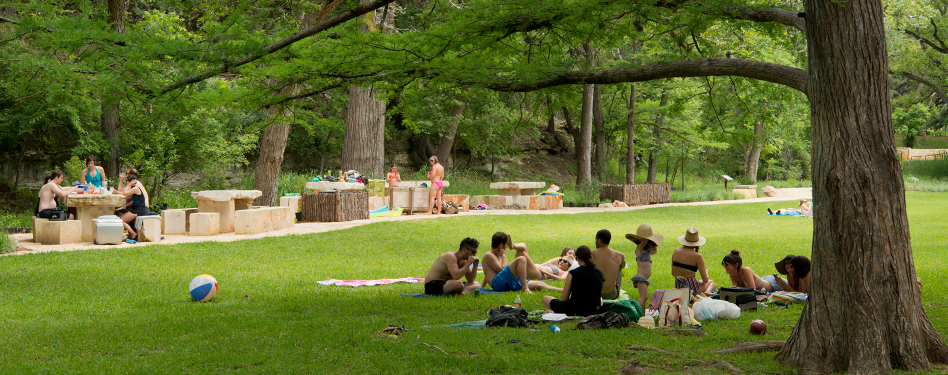
Photo copyright: D. A. Horchner / Design Workshop, Inc.
Sustainable landscapes create ecologically resilient communities better able to withstand and recover from episodic floods, droughts, wildfires and other catastrophic weather events. By aligning land design and development practices with the functions of healthy ecosystems, the SITES program demonstrates how land built sustainably has the ability to protect and restore essential functions, or ecosystem services, and enhance the quality of life in a community.
Incorporating green infrastructure can achieve desired outcomes like reducing and cleaning stormwater runoff and providing access to more vegetation. Using these practices, land developers are able to decrease reliance on traditional stormwater technologies or grey infrastructure (e.g., pipes, pumps, ditches) which typically work only to move water away from a site as quickly as possible.
The SITES framework, which highlights green infrastructure practices, guided the design and development of Blue Hole Regional Park,126 acres that include a beloved swimming spot on Cypress Creek, located in the heart of Texas Hill Country’s karst landscape. Since its opening, Blue Hole has recovered from five floods up to 27 feet in depth.
In fact, even in the wake of the tragic 2015 Memorial Day Flood, which claimed 12 lives on the Blanco River, the park remained resilient, without plant loss, damage to hardscape, materials or amenities. This was achieved through 10 micro-detention ponds connected by bioswales and rain gardens to slow, filter and drain stormwater before it enters Cypress Creek. To achieve some of the SITES prerequisites and credits, 100 percent of the streambank along Cypress Creek at Blue Hole was restored using amended soils and deep-rooted, native plants. In addition, a 2,900-gallon cistern greets visitors and reminds them that water is a precious resource in a land prone to seasonal flooding and droughts.
With 19 species of concern making their home at the site, including the golden-cheeked warbler, western burrowing owl and Blanco River Springs salamander, the partnership formed between the community and the construction team early on was critical to habitat protection.
At “Plant My Park Days,” volunteers transplanted tree saplings along the streambank to ensure regenerative growth. Today, 31 ecologically valuable/biodiverse hardwood, prairie grass and forb species thrive in the landscape. Minimizing disturbance was key: 320,000 square feet of new program was sited in previously disturbed areas, which allowed for the protection of 96 percent of the untouched landscape. Ashe junipers, an invasive species removed during restoration, were thoughtfully repurposed for bollards, fencing, light poles, wheel stops, art, nature-based play or mulch around trees, trails and play areas.
Economically, the park reduced cost by approximately $270,000 during construction by recycling land-clearing material into mulch and reusing excavated limestone instead of purchasing new materials. In its first year, the park experienced an increase of 60 percent in visitors, while in the second year, visitation nearly doubled again, generating an estimated $217,000.
Recovering from floods quickly and effectively has also been economically beneficial. As an early adopter of SITES, Blue Hole Regional Park achieved SITES certification in 2013, during the pilot program. Since then, it has proven that SITES creates regenerative systems and fosters resiliency, among the many other ecological, social and economic benefits.
